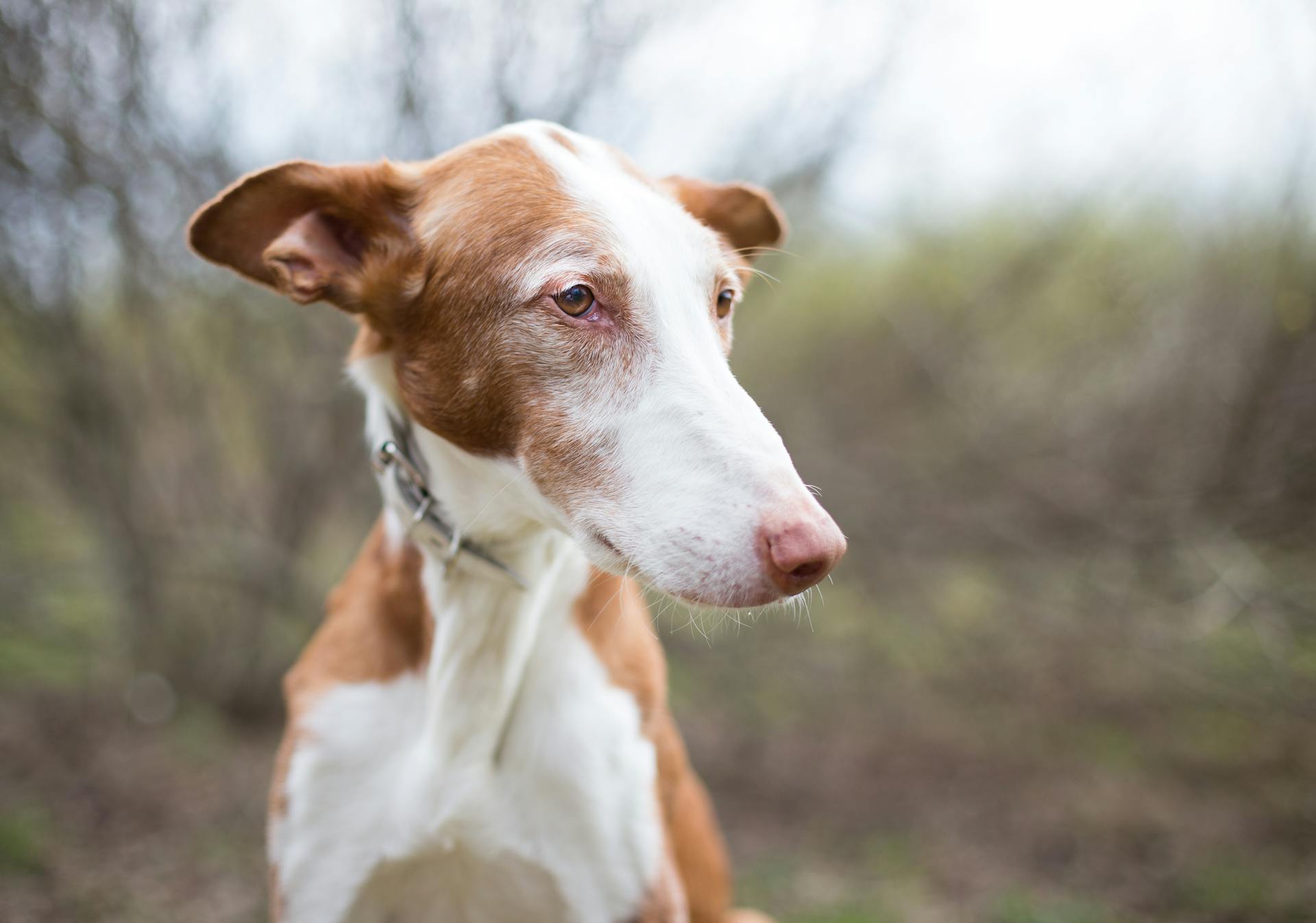
Canine lymphoma progression is a complex and multifaceted process. Lymphoma is a type of cancer that affects a dog's immune system, specifically the lymph nodes, spleen, and other lymphoid tissues.
It's estimated that 1 in 5 dogs will develop lymphoma in their lifetime. This makes it one of the most common types of cancer in dogs.
Lymphoma can progress rapidly, with some dogs experiencing a decline in health within just a few weeks. Early detection and treatment are crucial to improving a dog's chances of survival.
Understanding the stages of canine lymphoma is essential for effective treatment and management.
What is Lymphoma in Dogs?
Lymphoma in dogs is a serious condition that's often associated with enlarged lymph nodes.
Most dogs with enlarged lymph nodes have lymphoma. Unfortunately, an inflammatory or infectious cause is rare, even in dogs with extremely irritated skin.
The majority of lymphomas are high-grade and rapidly progressive, which means they can spread quickly if left untreated.
If left untreated, most dogs reach terminal stages one to two months from presentation.
With chemotherapy, the majority of dogs will achieve complete remission, meaning all signs of cancer disappear.
Workup, Diagnosis & Staging
To determine the cause of your dog's symptoms, a veterinarian will typically perform a complete physical examination, including bloodwork and urinalysis. This is usually the first step in diagnosing canine lymphoma.
A veterinarian may also perform additional procedures, such as three-view chest X-rays and an abdominal ultrasound, to determine whether there are tumors or if the cancer has metastasized. These tests can help identify the extent of the cancer.
If enlarged lymph nodes or a mass in the chest are among the symptoms, a fine needle aspiration may be performed to draw a sample of the tissue for further testing. This can provide valuable information about the type of lymphoma your dog has.
A biopsy may be needed in some cases to confirm the diagnosis. Specialized tests, such as flow cytometry and the PARR test, can help further characterize the disease into B-cell lymphoma or T-cell lymphoma.
The stage of the cancer is critical for treatment planning. Here's a breakdown of the different stages of canine lymphoma:
Treatment Options
Treatment options for canine lymphoma depend on your pet's tolerance, cost, and quality of life. Treatment selection can be a complex process, but it's essential to consider your goals and your dog's overall well-being.
Chemotherapy is the prevailing treatment option for canine lymphoma, and it's typically administered intravenously, although some forms can be given orally. About 85% of dogs will go into remission with treatment.
Most dogs tolerate chemotherapy well, but about 15% may experience side effects, which can include nausea, vomiting, diarrhea, and a reduced appetite. Side effects usually begin within the first four days of treatment and can last for four days.
Low-dose rate half-body irradiation with chemotherapy has shown to significantly improve survival times compared to traditional chemotherapy alone, particularly for dogs with B-cell lymphoma. This combined protocol involves integrating radiation therapy early in the treatment process.
If all treatment options are declined, the disease can progress quickly, and within weeks, you may see symptoms such as coughing, breathing difficulty, anorexia, and severe lethargy. Decisions based on a dog's quality of life will have to be made at this point.
Chemotherapy is well-tolerated in dogs, with a less than 25% risk of mild side effects that are manageable at home. The risk of severe side effects requiring veterinary care is less than 5%.
Related reading: Canine Bone Cancer Life Expectancy
Prognosis and Side Effects
Dogs with lymphoma typically have a poor prognosis, with a median survival time of 12 months for B-cell lymphoma and 6-9 months for T-cell lymphoma.
Chemotherapy is the standard treatment, but it's not a cure. With oral steroids alone, the prognosis is even poorer, at 1-2 months.
Most dogs tolerate chemotherapy well, with a less than 5% risk of severe side effects requiring veterinary care. Mild side effects, like vomiting and diarrhea, are manageable at home with medication.
Related reading: Canine Cancer Prognosis
Prognosis
Lymphoma in dogs is a serious condition with varying prognosis depending on the type of cancer. Dogs with B-cell lymphoma have a median survival time of 12 months.
Chemotherapy is effective in treating lymphoma, but it's not a cure. With a standard protocol, dogs with B-cell lymphoma can live for 12 months on average.
Dogs with T-cell lymphoma have a shorter median survival time, ranging from 6-9 months. This means that 50% of pets with T-cell lymphoma will live less than this time, and 50% will live longer.
The prognosis with oral steroids alone is much shorter, typically lasting only 1-2 months.
Take a look at this: Hemangiosarcoma in Dogs Survival Rate
Chemotherapy Side Effects
Chemotherapy side effects are generally mild and manageable at home, with a less than 25% risk of mild side effects and a less than 5% risk of severe side effects requiring veterinary care.
Temporary vomiting and diarrhea are common side effects, as well as temporary decreases in appetite and energy.
Some dogs may experience a decrease in white blood cell counts, making them more susceptible to infection.
Most chemotherapy protocols have specific side effects, which are discussed at the time the medication is given.
About 15% of dogs will experience side effects, which can include nausea, vomiting, diarrhea, and/or a reduced appetite.
Side effects usually begin within the first four days of treatment and can last for four days.
Dogs may lose their fur, especially those with hair-like coats, such as Poodles, Bichon Frises, and Terriers.
After chemotherapy, dogs can do well for six to 12 months, depending on the type of lymphoma and the chemotherapy protocol used.
Prevention and Risk
Lymphoma can be prevented in some cases by reducing exposure to environmental toxins and chemicals, particularly pesticides and herbicides, which have been linked to increased risk of canine lymphoma.
Some breeds are more prone to lymphoma, including Basset Hounds, Cocker Spaniels, and Scottish Terriers.
A diet high in processed foods and low in nutrients can contribute to the development of lymphoma.
Obesity is a significant risk factor for lymphoma, particularly in large and giant breed dogs.
Early detection and treatment can significantly improve survival rates in dogs with lymphoma.
Frequently Asked Questions
What are the symptoms of the final stages of lymphoma in dogs?
Symptoms of the final stages of lymphoma in dogs include loss of appetite, labored breathing, incontinence, and immobility, often accompanied by glassy eyes and restlessness
When to euthanize a dog with lymphoma?
Euthanization may be considered if your dog's lymphoma causes unmanageable pain, unremovable tumors, or significant decline in quality of life, leading to symptoms like lethargy, incontinence, or difficulty breathing. Consult with a veterinarian to determine the best course of action for your pet's well-being.
How long can a 12 year old dog live with lymphoma?
Treatment outcomes vary, but with aggressive treatment, a 12-year-old dog with lymphoma may live over two years. However, without treatment, a dog's lifespan is typically just a month
Sources
- https://hospital.cvm.ncsu.edu/services/small-animals/cancer-oncology/oncology/canine-lymphoma/
- https://www.thepetoncologist.com/faqs-lymphoma-in-dogs
- https://www.vetspecialists.co.uk/fact-sheets-post/lymphoma-in-dogs-fact-sheet/
- https://avim.us/canine-lymphoma/
- https://petcureoncology.com/lymphoma-in-dogs/
Featured Images: pexels.com


